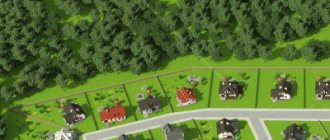One of the promising options for their use is construction, and it is preferable to carry it out on individual housing construction lands.
In addition, such plots have access to the infrastructure of the locality in which they are located, and also, connection to communications occurs at government rates.
We will talk about what such areas are, the features of their use and advantages in this material.
How is this status deciphered and what does it mean?
The abbreviation individual housing construction is found in the text of the administrative document for a land plot, the cadastral passport and the certificate confirming the owner’s rights to the land, so it is important to understand what it is and what it means.
It means an abbreviated name for one of the types of permitted use of a land plot and stands for individual housing construction .
Types of permitted use - hereinafter referred to as VRI, were introduced into the practice of land exploitation by the VRI classifier of land plots, approved by the Ministry of Economic Development of Russia on September 1, 2014, with changes that will become relevant in 2021.
You can read more about the VRI classifier in the article.
A plot with VRI - individual housing construction can be used as follows:
- construction of a low-rise residential building;
- construction of auxiliary outbuildings;
- setting up a garden for your own needs.
At the same time, legislators prohibit the use of land with individual housing construction status for the following purposes:
- construction of houses with several apartments.
- processing of agricultural products as an option for business activities;
- location of municipal and industrial facilities;
- production and sale of products for ritual purposes.
Plots for individual housing construction are located exclusively on the lands of populated areas.
Purchase of land for individual housing construction
You can purchase land for individual housing construction in the following ways:
- by purchasing from a private person;
- by participating in government auctions;
- renting;
- changing the existing status to individual housing construction;
- taking advantage of the right to receive free of charge.
To buy land from a private owner you will need to take the following steps:
- find a suitable site;
- check all documentation and purpose of the land;
- provide the seller with a deposit;
- complete a purchase and sale transaction;
- register property rights.
To take part in the auction you will need:
- submit the appropriate application to the municipality;
- present an identification document;
- deposit the specified deposit amount into the cash register;
- take part in the auction.
It is worth considering that the initial price, as well as the bidding step, are set by the administration. The contract is concluded with the participant who offers the highest price. Based on this, materials on the ownership of the site are drawn up.
Land selection rules
, the choice of the optimal location of the land
comes into focus .
Each person requires different conditions, but most of them can be summed up under some single criterion.
Let's consider the nuances that need to be taken into account so as not to encounter unpleasant surprises later:
- When planning the construction of a country cottage, look for a site located in close proximity to recreational facilities - ponds, forests.
- For the construction of a permanent residential building, preference should be given to areas located close to social facilities - kindergartens and schools, hospitals and cultural institutions. The presence of markets, as well as stores selling everyday goods, is welcome.
- Convenient access roads making it easy to travel with your own car.
- Availability of utilities or the possibility of promptly connecting them and connecting the house to them.
Owners of plots allocated for individual housing construction have the right to expect proper maintenance of roads , including their winter clearing. The municipality is responsible for this.
Type of development
Urban planning legislation allows the construction of objects for personal use with a height of no more than three floors .
It can be:
- Residential buildings . Buildings cannot be multi-entrance, designed to accommodate several families or be used for commercial purposes.
- Garages . The same rule applies as in the previous case - a ban on using the object for the purpose of obtaining profit. When placing a building, maintaining a distance from nearby buildings is required. Study the SNiP standards.
- Bathhouse . A fire-hazardous facility requires compliance with fire safety rules during construction. Being an auxiliary structure, it does not require a building permit. Use for commercial purposes is prohibited.
- Other outbuildings – woodsheds, sheds, greenhouses, gazebos. According to the law, buildings of this type must be located deep in the site. Construction must be carried out in compliance with the distances recommended by SNiPs.
A popular construction project - a hotel - can be built on individual housing construction lands if there is appropriate permission from the administrative authority.
Read about what can be built on individual housing construction sites in a separate article.
REQUIREMENTS FOR IZHS
- Construction on such land ownership is determined by construction SNiP.
- On landownership category individual housing construction, the construction of small, low-rise mansions is permitted.
- Outbuildings and court buildings are permitted: a bathhouse, greenhouse structures, courtyard premises for breeding animals and birds.
- The premises must be for residential use only and not a commercial building.
- The building is located further than 5 meters from the road and 3 meters from dead ends.
- It is recommended that household facilities be located deep in the land, not close to the street.
- From the fence to the building boundary is at least 1-1.5 meters.
- There should be more than 4 meters between buildings. But in SNiP it is specified; it depends on the construction materials of the building.
- A latrine and a pit with sewage waste are further than 1 meter from the border of the neighboring estate.
- There are special requirements for the distance to the neighboring territory.
- A garage or other household facility must have a distance from the boundaries of neighbors of more than 3 meters, and from the forest no less than 15 meters. The minimum distance from the home to the barn and household objects must be more than 4 meters, and to the neighbor’s mansion - 12 meters. The distance between your neighbor’s home and your bathhouse is 8 meters. If a citizen violates construction standards, he will be held administratively liable. The owner will be required to demolish the building.
Shaping and Size
When forming a plot allocated for individual housing construction, local self-government bodies are guided by the following conditions:
- presence of unoccupied territories;
- the level of population demand for land plots for construction;
- degree of population of the area;
- assessment of the feasibility of allocating a land plot in accordance with the priority of territory development.
The size of the plot can be from 3 to 30 acres.
It also depends on the area of the future house - there is a requirement for the area allocated for construction - ensuring the free placement of building materials, special vehicles, and auxiliary installations on it.
Type of permitted use
Construction on lands not intended for this purpose is punishable by fines, as well as orders to demolish illegal buildings.
You can clarify the VRI of a specific plot of land by contacting the Rosreestr authorities:
- Order a cadastral passport for the plot. The VRI line, in accordance with the records in the state real estate cadastre, contains information about how the site can be used.
- Cadastral extract about the plot. The Permitted Use line contains the information you are looking for.
You can request data:
- during a personal visit to the Rosreestr authorities or through the website,
- through the MFC,
- State Services website.
In accordance with the current VRI classifier, individual housing construction is indicated in documents as “low-rise residential development” .
For information on how to find out the VRI of a site, read the thematic material at the link.
An administrative act of a local government establishing the VRI of an individual housing construction site can serve as the basis for the start of housing construction work.
Validity period of the permit
By law, construction work must begin no later than three years after its acquisition. According to Article 284 of the Town Planning Code, the construction site must be used only for its intended purpose.
If during this time the land is not properly used, that is, the construction of a residential building has not begun, there is a risk of its seizure by the state without compensation. This period does not include the time of its development, periods when use was impossible for reasons beyond the control of the owner.
It is mandatory to notify the owner of improper use and provide the necessary time to correct the situation. Often, building a foundation or even a trailer for tools is enough to “stake out” a site, declaring it to be developed.
Having received permission to build according to an individual architectural plan, or having notified the relevant departments about its start, you don’t have to worry about the ten years usually provided for the construction of a residential building by law.
Advantages
The undeniable advantages of carrying out construction work on a site for individual housing construction are:
- instant assignment of an address to a built house;
- hassle-free registration at your place of residence ;
- guaranteed provision of all necessary communications;
- close location of social facilities, as well as transport, engineering and utility infrastructure;
- the fee for owning a house is limited to the amount of property tax for individuals;
- the amount of tax on individual housing construction plots is lower than on plots of the same area on agricultural lands and areas allocated for gardening.
- the possibility of obtaining tax deductions for personal income tax for the construction of a house;
- using land as collateral when taking out a mortgage loan;
- receiving maternity capital for a built house.
Hunters will be interested in the possibility of obtaining official permission to store firearms. Houses built on plots with a different VRI do not provide such an advantage to their owner.
Read more about the advantages of individual housing construction in comparison with garden plots in this article, and the differences from private household plots in this article.
Expert advice
To avoid many mistakes, remember a few tips:
- Individual housing construction can be carried out exclusively on the lands of populated areas.
- Having bought a plot of land of the SNT or DNP category , do not hope that someone will start developing this territory and arranging its social infrastructure.
- It is much more economical to pay an increased tax on a site than to conduct communications to it using your own funds.
- When buying land under SNT or DNP , you are faced with the problem of communications, which, despite the low price, will not pay off.
- Plots that have recently been transferred from the category of agricultural use to individual housing construction are cheaper.
- Before making a purchase, carefully study the land documentation. This will help you avoid falling for the cunning tricks of scammers.









